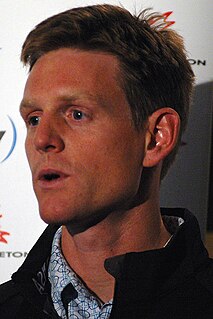Related Research Articles

James Edmound Shea Jr. is an American skeleton racer who won the gold medal at the 2002 Winter Olympics in Salt Lake City. Shea also was chosen by fellow athletes to recite the Athlete's Oath during the Opening Ceremonies. Along with his father, Jim Shea Sr., he passed the Olympic Torch to Cammi Granato and Picabo Street who then passed it to the 1980 U.S. Men's Hockey Team, who then ignited the Olympic Cauldron. Shortly before the Olympics he was a guest of Laura Bush in the First Lady's Box at the 2002 State of the Union Address.

Bobsleigh or bobsled is a team winter sport that involves making timed runs down narrow, twisting, banked, iced tracks in a gravity-powered sleigh. International bobsleigh competitions are governed by the International Bobsleigh and Skeleton Federation, also known as FIBT from the French Fédération Internationale de Bobsleigh et de Tobogganing. National competitions are often governed by bodies such as the United States Bobsled and Skeleton Federation and Bobsleigh Canada Skeleton.

The 1928 Winter Olympics, officially known as the II Olympic Winter Games, were a winter multi-sport event which was celebrated February 11–19, 1928 in St. Moritz, Switzerland.

Skeleton is a winter sliding sport in which a person rides a small sled, known as a skeleton bobsled, down a frozen track while lying face down and head-first. The sport and the sled may have been named from the bony appearance of the sled.

Sledding, sledging or sleighing is a winter sport typically carried out in a prone or seated position on a vehicle generically known as a sled, a sledge (British), or a sleigh. It is the basis of three Olympic sports: luge, skeleton and bobsledding. When practised on sand, it is known as a form of sandboarding. In Russia sledges are used for maritime activities including fishing and commuting from island to island

David Ludovic George Hopetoun Carnegie, 11th Earl of Northesk was elected a Scottish representative peer. He was also a skeleton competitor who won a bronze medal at the 1928 Winter Olympics.

Duff Gibson is a Canadian skeleton racer who competed from 1999 to 2006. He was born in Vaughan, Ontario. His father was born on December 13, 1937. At the 2006 Winter Olympics in Turin, He won the gold medal in the men's skeleton, narrowly beating out his teammate Jeff Pain. His victory made the 39-year-old surpass ice hockey player Al MacInnis as the oldest gold medallist in Canadian Winter Olympic history. More significantly, Gibson became the oldest individual gold medallist in the history of the Winter Games, a record previously held by Norway's Magnar Solberg, who was 35 when he won the gold medal in the 20 km individual biathlon event at the 1972 Winter Olympics in Sapporo; he held the record until Ole Einar Bjørndalen won gold at the 10 km biathlon sprint aged 40 at the 2014 Sochi Olympics. He retired immediately following the 2006 Games in Turin.
Florian Grassl is a German skeleton racer who has competed since 2002. He won a silver medal in the men's skeleton event at the 2004 FIBT World Championships in Königssee.

Gregor Stähli is a Swiss skeleton racer who has competed since 1989. He won two bronze Winter Olympic medals in the men's skeleton, earning them in 2002 and 2006.

Jeffrey Thomas "Jeff" Pain is an American-born Canadian former skeleton racer who competed from 1995 to 2010. He is regarded as one of the most successful male competitors in the history of the Canadian skeleton program. He was born in Anchorage, Alaska.
Martin Rettl is an Austrian skeleton racer who competed from 1989 to 2006. Competing in two Winter Olympics, he won a silver medal in the men's skeleton event at Salt Lake City in 2002.
These are the results of the men's skeleton competition at the 1928 Winter Olympics in St. Moritz. At that time the sport was called cresta, and St. Moritz had the most famous Cresta Run, dating to 1884. In many locations the sport was referred to as tobogganing during these and the 1948 Games. The competition took place on the Cresta Run and medals were awarded after a total of three runs down the course.

Skeleton is a winter sport featured in the Winter Olympics where the competitor rides head-first and prone on a flat sled. It is normally run on an ice track that allows the sled to gain speed by gravity. It was first contested at the 1928 Winter Olympics in St. Moritz and again in 1948 Winter Olympics, after which it was discontinued as an Olympic sport. Skeleton was reintroduced at the 2002 Salt Lake City Olympics, with both men's and women's events, and has been held in each Winter Olympic competition since. Skeleton is so-named as the first metal sleds introduced in 1892 were said to resemble a human skeleton.

The International Luge Federation is the main international federation for all luge sports. Founded by 13 nations at Davos, Switzerland in 1957, it has members of 53 national luge associations as of 2009 and is based in Berchtesgaden, Germany.

Jennison Heaton was an American bobsled and skeleton racer. He competed at the 1928 Winter Olympics and won a gold medal in the skeleton event and a silver in the five-man bobsleigh competition. In the skeleton, Heaton beat the silver medalist by one second. His other brother Trowbridge was also a bobsleigh enthusiast. Heaton later married Beulah Fiske, becoming the brother-in-law of Billy Fiske, also an Olympic bobsledder.
John Rutherford "Jack" Heaton was an American bobsledder and skeleton racer who competed from the late 1920s to the late 1940s.
Alexander Berner was a Swiss skeleton racer who competed in the late 1920s. He finished fifth in the men's skeleton event at the 1928 Winter Olympics in St. Moritz.
For the 1928 Winter Olympics in St. Moritz, Switzerland, a total of five sports venues were used. The main stadium hosted the figure skating, ice hockey, and speed skating events. Skeleton was first held at the Cresta Run. Bobsleigh was held at the bob run. St. Moritz itself served as cross-country skiing venue and the cross-country part of the Nordic combined event. Weather gave two events run at these games problems, creating the largest margin of victory in Olympic history for one and the cancellation of the other.
For the 1948 Winter Olympics in St. Moritz, Switzerland, a total of eight sports venues were used. The five venues used for the 1928 Winter Olympics were reused for these games. Three new venues were added for alpine skiing which had been added to the Winter Olympics program twelve years earlier in Garmisch-Partenkirchen, Germany. As of 2015, the bob run continues to be used for bobsleigh and the Cresta Run for skeleton while alpine skiing remains popular in St. Moritz.
References
- ↑ Wallechinsky, David (1984). "Skeleton (Cresta Run)". The Complete Book of the Olympics: 1896-1980. New York: Penguin Books. p. 576.
- ↑ 1928 men's skeleton results
- ↑ Skeletonsport.com profile Archived 2011-09-28 at the Wayback Machine
| This biographical article relating to Austrian winter sports is a stub. You can help Wikipedia by expanding it. |
| This biographical article relating to skeleton racing is a stub. You can help Wikipedia by expanding it. |